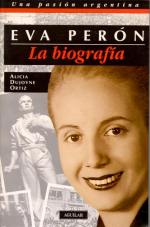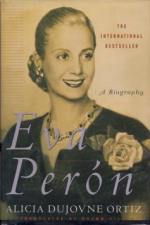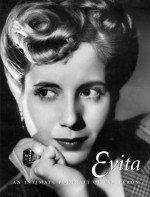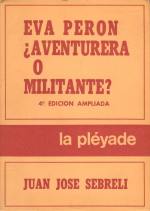*Acossano, Benigno.
Eva Perón: su verdadera vida.
Buenos Aires: Editorial Lamas, 1955.
Aizcorbe, Roberto.
Argentina: The Peronist Myth.
Hicksville, N.Y.: Exposition Press, 1975.
Akridge, Sharon Hollenbeck.
"Cinderella From the Pampas."
Ph.D. dissertation, University of California, Santa Barbara, 1976.
*Alexander, Robert J.
An Introduction to Argentina.
New York: Praeger, 1969.
________.
Juan Domingo Perón: A History.
Boulder Colo.: Westview Press, 1979.
________.
The Perón Era.
New York: Columbia University Press, 1951.
Alonso Piñeiro, Armando.
La dictadura peronista.
Buenos Aires: Editorial Prestigio, 1955.
Ara Sarria, Pedro.
El caso Eva Perón: apuntes para la historia.
Madrid: CVS Ediciones, 1974.
Argentina en marcha.
Buenos Aires: Subsecretaría de Informaciones de la Presidencia de la Nación, 1950.
Baily, Samuel L.
Labor, Nationalism, and Politics in Argentina.
New Brunswick, N.J.: Rutgers University Press, 1967.
*Barager, Joseph R., ed.
Why Perón Came to Power: The Background to Peronism in Argentina.
New York: Knopf, 1968.
*Barnes, John.
Evita, First Lady.
London: W. H. Allen, 1978.
New York: Grove Press, 1978.
Benedetti, Antonio.
Perón y Eva: Trayectoria y fin de un régimen.
Mexico City: Editores Pan Americanos Asociados, 1956.
*Blanksten, George I.
Perón’s Argentina.
Chicago: University of Chicago Press, 1953.
Boizard, Ricardo.
Esa noche de Perón. 3rd ed.
Buenos Aires: Editorial DE-DU S.R.L., 1955.
Borroni, Otelo, and Vacca, Roberto.
Eva Perón.
La historia popular, vol. 9. Buenos Aires: Centro Editor de América Latina, 1971.
________.
Vida de Eva Perón.
Buenos Aires: Editorial Galerna, 1970.
Bruce, George.
Eva Perón.
London: Heron Books, 1970.
Bruce, James.
Those Perplexing Argentines.
New York: Longmans, Green, & Co., 1953.
Brun, Mario Merde.
Eva Perón: Abanderada de la justicia social.
Buenos Aires: Subsecretaría de la Informaciones de la Presidencia de la Nación, 1951.
Buenos Aires Herald,
2 January-30 April 1950; 21 May-31 August 1952.
CBS-TV.
"Perón and Evita," The Twentieth Century.
Narrated by Walter Cronkite; produced by Burton Benjamin; written by Ray Josephs.
New York: CBS News, 1958.
Cantarella, Adlina.
Guía para análisis analógico de "La razón de mi vida" de Eva Perón.
Buenos Aires: Libreria Perlado, 1954.
Chávez, Fermín.
Perón y el peronismo en la historia contemporánea.
Buenos Aires: Editorial Oriente, 1975.
Ciria, Alberto, et al.
New Perspectives on Modern Argentina.
Bloomington, In.: Latin American Studies Program, Indiana University, 1972.
________.
Parties and Power in Modern Argentina.
Translated by Carlos A. Astiz with Mary F. McCarthy.
Albany: State University of New York Press, 1974.
La constitución nacional de 1949.
Buenos Aires: Rodolfo Alonso Editor, 1974.
Corradi, Juan Eugenio.
"Argentina." In Latin America: The Struggle with Dependency and Beyond, pp. 307-407.
Edited by Ronald H. Chilcote and Joel C. Edelstein.
Cambridge, Mass.: Schenkman, Halsted Press, 1974.
*Cowles, Fleur.
Bloody Precedent.
New York: Random House, 1952.
Crespo Rodas, Alfonso.
Evita:viva o muerta.
Barcelona: Editorial Fontalba, 1980.
Damonte Taborda, Raúl.
¿A dónde va Per6n: de Berlin a Wall Street?
Montevideo: Ediciones de la Resistencia Revolucionaria Argentina, 1955.
________.
Ayer fué san Perón: 12 años dey Eva Perón.
Buenos Aires: Grupe Editorde, 1966.
*de Elia, Tomás and Juan Pablo Queiroz.
Evita: An Intimate Portrait of Eva Perón.
New York: Rizzoli, 1997.
De La Sota, Julio Ellena.
La acción política de Eva Perón.
Buenos Aires: n.p., n.d.
De Martinez Paiva, Celina R. and María Rosa Pizzuto de Rivero.
La verdad: Vida y obra de Eva Peron, Primera Parte: Eva, adalid de Octubre.
Buenos Aires: Editorial Astral, 1974.
De Virgilio, Francisco.
Eva Perón: Heroina y martir de la patria.
Buenos Aires: Editorial Italgraf, 1974.
Declaración de los derechos del trabajadore.
Buenos Aires: n.p., 1947.
*Diego García, Fernando, Alejandro Labado, Enrique Carlos Vásquez, eds.
Evita: Imagenes de una pasion.
Mexico City: Grupo Editorial Zeta S.A., 1997.
Dolkart, Ronald H.
"The Reperonism of Argentina, 1955-1975."
In Latin America: Power and Poverty, pp. 65-74.
Proceedings of the Pacific Coast Council on Latin American Studies.
San Diego, Calif.: San Diego State University Press, 1975.
*Duarte, Erminda.
Mi hermana Evita.
Buenos Aires: Ediciones "Centro de estudios Eva Perón," 1972.
Engle, Lehman.
The Critics.
New York: Macmillan, 1976
*Eva Perón: Album Fotographico.
Buenos Aires: Subsecretaría de Informaciones, 1952.
Eva Perón.
Buenos Aires: Cuadernos de crisis, número 7, 1974.
Eva Perón en el bronce.
Buenos Aires: Subsecretarìa de Informaciones de la Presidencia de la Nación, 1952.
Falcoff, Mark.
"What was Peronismo, 1945-1955?"
In Latin America: Power and Poverty, pp. 65-74.
Proceedings of the Pacific Coast Council on Latin American Studies. San Diego, Calif.: San Diego State University Press, 1975.
Falcoff, Mark, and Ronald H. Dolkart, eds.
Prologue to Perón: Argentina in Depression and War, 1930-1943.
Berkeley: University of California Press, 1975
Fernández, Julio A.
The Political Elite in Argentina.
New York: New York University Press, 1970.
Ferns, Henry S.
Argentina.
London: Ernest Benn, 1969.
________.
The Argentine Republic, 1516-1971.
Newton Abbot, England: David & Chartes, 1973.
Ferrer, Aldo.
The Argentine Economy.
Translated by Marjory M. Urquidi.
Berkeley and Los Angeles, Calif.: University of California Press, 1967.
Fillol, Tomás Roberto.
Social Factors in Economic Development: The Argentine Case.
Cambridge, Mass.: M.I.T. Press, 1961.
Fitzgibbon, Russell H.
Argentina: A Chronology and Fact Book, 1516-1973.
Dobbs Ferry, N.Y.: Oceana, 1974.
Foster, Derek H. N.
The Argentines, How They Live and Work.
New York: Praeger, 1972.
Franco, Alberto.
La mística social de Eva Perón.
Buenos Aires: Subsecretaría de Informaciones, 1954.
*Fraser, Nicholas, and Marysa Navarro.
Eva Perón.
London: Andre Deutsch, 1980.
Fundacion Eva Peron Escuela de Enformas,
n.p., n.d.
Gambini, Hugo.
El dieciesiete de octubre de 1945.
Buenos Aires: Editorial Brujula, 1969.
García, Enrique Eduardo.
Radiografia politica del General Perón.
Buenos Aires: Miranda, n.d.
*Ghioldi, Américo.
De la tirania a la democracia social.
Buenos Aires Ediciones gure, 1956.
*________.
El mito de Eva Duarte.
Montevideo: Compania impressora, 1952.
Goldwert, Marvin.
Democracy, Militarism and Nationalism in Argentina, 1930-1966: An Interpretation.
Latin American Monographs.
Austin, Texas: University of Texas Press, Institute of Latin American Studies, 1972.
Gould, Lois.
La Presidenta.
New York: Simon & Schuster, Linden Press, 1981.
Greenup, Leonard, and Greenup, Ruth Robinson.
Revolution Before Breakfast: Argentina 1941-1946.
Chapel Hill, N.C.: University of North Carolina Press, 1967.
Hada Buena Argentina. n.p., n.d.
Harbinson, W. A.
Evita! A Legend for the Seventies. Designed by Mike Ricketts.
London: W. H. Allen, Star Books, 1977.
Harbinson, W. A.
Evita: Saint or Sinner?
New York: St. Martin's, 1996.
Hodges, Donald C.
Argentina 1943-1976: The National Revolution and Resistance.
Albuquerque, N.M.: University of New Mexico Press, 1976.
________.
"Perón and After, Part II (Conclusion)."
Hispanic American Historical Review, 39 (May 1959) :212-223.
Hollander, Nancy Caro.
"Si Evita viviera."
In Women in Latin America pp. 101-117.
Riverside, Calif.: Latin American Perspectives, 1979.
________.
"Women: The Forgotten Half of Argentine History." In Female and Male in Latin America pp. 141-158.
Edited by Ann Pescatello. Pittsburgh: University of Pittsburgh Press, 1973.
________.
"Women in the Political Economy of Argentina." Ph.D. dissertation, University of California at Los Angeles, 1974.
*Imaz, José Luis de.
Los que mandan [Those Who Rule].
Translated and edited by Carlos A. Astiz.
New York: State University of New York Press, 1970.
Jaumandreu, Paco.
Evita fuera del balcón.
Buenos Aires: Ediciones del Libro Abierto, 1981.
Jolly, Julia A. "Eva Perón: Adventuress or Militant?"
In Latin America: Power and Poverty, pp. 75-88.
Proceedings of the Pacific Coast Council on Latin American Studies.
San Diego, Calif.: San Diego State University Press, 1975.
*Josephs, Ray.
Argentine Diary: The Inside Story of the Coming of Fascism.
New York: Random House, 1944.
Kirkpatrick, Jeane.
Leader and Vanguard in Mass Society: A Study of Peronist Argentina.
Cambridge, Mass.: M.I.T. Press, 1971.
Lack, John.
Eva Perón. n.p., 1958.
Lawrence, Jerome, and Robert E. Lee.
Sparks Fly Upward.
New York: Dramatists Play Service, 1967.
First performed as The Diamond Orchid, New York City, 1965.
Levene, Ricardo.
A History of Argentina.
Translated and edited by William S. Robertson.
Chapel Hill, N.C.: University of North Carolina Press, 1937.
Reprint. New York: Russell & Russell, 1963.
Libro negro de la segunda tiranía.
Buenos Aires: La nación Argentine, Comisión Nacional de Investigaciones, 1958.
*Llorca, Carmen.
Llamadme Evita: Un destino único de mujer.
Barcelona: Editorial Planeta, 1980
*Lloyd Webber, Andrew, and Rice, Tim.
Evita: The Legend of Eva Perón, 1919-1952.
London: Elm Tree Books, 1978.
Lombille, Román J.
Eva, la predestinada: alucinante historia de Exitos y frustraciones.
Buenos Alses: Ediciones gure, 1955.
Luna, Félix.
El cuarenta y cinco: Crónica de un año decisivo.
Buenos Aires: Editorial Jorge Alvarez, 1969.
Continued
* recommended
Design © 2001

Bibliography and Text© 1980, 2001 by Sylvia Stoddard







































































